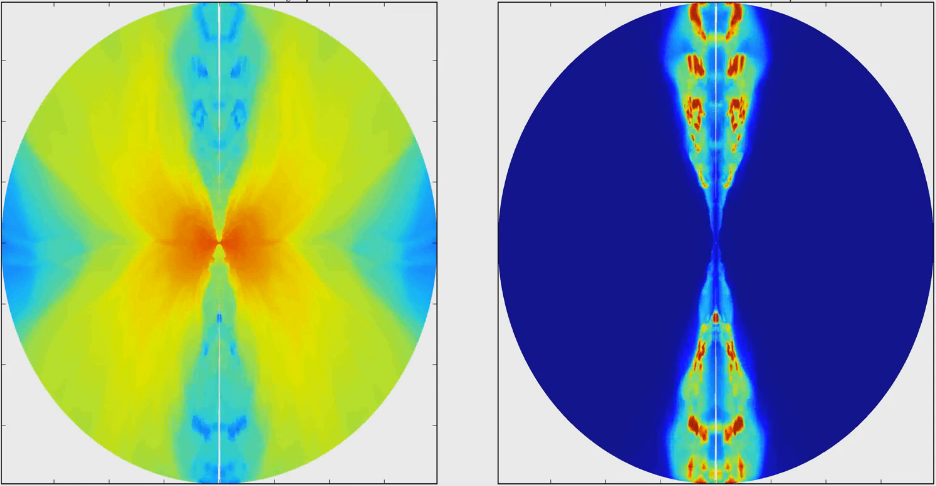Time: 22nd of September 2017, 20:54:30.43 Coordinated Universal Time. Location: cold Antarctica. A suspect has just activated the alarm. The panicked guards are running from monitor-to-monitor searching for a trace of the suspect. Trained hounds are being released smelling the air for familiar clues. Within 43 seconds the news has spread to investigators all over the world.
What you are reading is not a prison break scene but a very rare event. It’s the detection of a subatomic particle called neutrino from an experiment located a thousand meters beneath the Antarctic surface. Most likely, the scene didn’t evolve as I described above but it would have been extremely cool if it had!
In fact, this detection is extremely important because it was the first time a neutrino detection coincided with observations in other wavelengths, namely from γ rays up to radio. 43 seconds after the neutrino detection, an automated alert was distributed to the scientific community providing an initial estimate of the direction of the neutrino candidate for further observations. Immediately, a huge observing campaign started utilizing various telescopes and covering numerous wavelengths. During this campaign, Fermi/LAT detected a flaring γ ray source inside the error region of the neutrino event – or in other words, close enough to the neutrino detection area. X-ray observatories, such as Swift and NuSTAR confirmed the existence of the flaring source located around the location of the neutrino event. Further confirmation came from optical and radio observations. Furthermore, the Major Atmospheric Gamma Imaging Cherenkov (MAGIC) Telescope reported the detection in the TeV band (1TeV = 1012eV), six days after the initial alert.
But, let’s take it from the beginning.
The construction of the IceCube neutrino observatory started in 2005 and was completed in 2010. IceCube consists of more than 5000 optical sensors embedded in 1 km3 of the Antarctic ice-sheet. The detector consists of 86 vertical strings frozen into the ice, 125m apart from each other and at depths between 1450m and 2450m (see figure below). This multipurpose experiment is trying to address open fundamental scientific questions such as the properties of neutrinos and the nature of dark matter. Neutrinos are very well studied but poorly understood, especially those that are related to extreme phenomena in the Universe such as exploding stars, cataclysmic phenomena involving black holes and neutron stars and alongside many more astrophysical processes. Due to the fact that neutrinos interact weakly with matter, they can only be observed indirectly. Thus, IceCube’s optical sensors detect the light emitted by the produced particles after the collision of neutrinos with the molecules of the ice. These “daughter” particles travel faster than the speed of light in the ice and hence, produce Cherenkov radiation (see here).

(image from Berkley Lab)
How are neutrinos formed? This is a fundamental question IceCube is trying to address. The most famous theory so far is the following. When protons or heavier nuclei accelerate to high energies of the order of 100 TeV (1TeV = 1012eV) up to 100 EeV (1EeV = 1018eV), they can interact with other particles or photons and produce among others neutrinos. The target particles for these interactions can be other particles located at the same source where nuclei accelerate. In such a case, the neutrinos traversing the Universe, carry more information about the nature of the source, such as what is the population of particles that accelerate in the source, what is the composition of the matter (protons or heavier nuclei), or what is the number density and the magnetic field of this source. Thus, one can see that studying neutrinos that are of astrophysical origin, can provide a better understanding of the nature of the source.
Another mystery IceCube is trying to shed light on is where are these particles formed. Or in other words, what astrophysical sources are capable of producing neutrinos. There are many speculations but as far as there are no simultaneous detections of other messengers – like photons – there is no strong evidence for a correlation between neutrino events and astrophysical sources. At least, that was the case until September of 2017.
On the 22nd of this month, the first detection of a neutrino of astrophysical origin and a correlation to a particular source came to existence. In particular, IceCube collaboration has developed an automatic real-time system that rapidly notifies the community for neutrino candidates. Satellites and telescopes that receive this message can instantly rotate their sensors to search for an optical counterpart.
Such an incident occurred on the 22nd of September of 2017. IceCube emitted an automated alert for a neutrino candidate of astrophysical origin and of energy of 290TeV. Unfortunately, another active neutrino observatory, namely ANTARES, reported that no neutrino candidates were found in a one day period around the event time. ANTARES is located in the Mediterranean sea and its sensitivity at the declination of IceCube’s event is one-tenth. Nevertheless, a huge campaign was initiated in order to detect any potential counterpart source by any means.
First of all, the GeV (1GeV=109eV) γ-ray satellite Fermi/LAT, reported that 0.1 degrees from the neutrino direction a known γ-ray source is located and at that moment it was in an enhanced emission. This source’s most commonly used name is TXS 0506+056, after the Texas Survey of radio sources. TXS 0506+056 is a blazar which means that it’s an Active Galactic Nucleus that launches a relativistic jet (see previous posts by Fe or Koushik) that points towards Earth. Along with to Fermi/LAT, the Astro-Rivelatore Gamma a Immagini Leggero (AGILE) γ-ray telescope confirmed the elevated level of γ-ray emission at energies of 0.1GeV from TXS 0506+056 in a 13-day period.
Imaging Atmospheric Cherenkov telescopes such as High-Energy Stereoscopic System (H.E.S.S.) and the Very Energetic Radiation Imaging Telescope Array System (VERITAS) γ-ray telescope array, did not manage to detect any γ-ray emission from the source. On the other hand, MAGIC did manage to detect this source in the TeV band six days after the neutrino candidate. As mentioned above, the multi-wavelength effort was completed with the contribution of X-ray telescopes and from optical to radio surveys.

(The IceCube Collaboration et al., 2018).
So, back to the initial question of the article; can flaring blazars be the origin of high-energy neutrinos? Despite this first detection and correlation between a single neutrino and a flaring source, scientists cannot conclude that this is a one-to-one relation. In particular, scientists dug into the archival data of both IceCube and Fermi/LAT and found that the same γ-ray source produced an excess of high-energy neutrino events between September 2014 and March 2015. At this moment though, the TXS 0506+056 source wasn’t in a flaring condition but still seems that it was able to produce an excess of neutrinos. Consequently, one cannot conclude that flaring blazars are the sources of neutrinos but perhaps, blazars, in general, are good candidates for high-energy astrophysical neutrino sources. Moreover, despite the current knowledge of the high-energy neutrino sources, the new era of multi-messenger Astrophysics seems to be settling in the scientific community and providing hopeful new information.

Interested in further details? Here are some suggestions:
– Multimessenger observations of a flaring blazar coincident with high-energy neutrino IceCube-170922A,
– Neutrino emission from the direction of the blazar TXS 0506+056 prior to the IceCube-170922A alert.




